
Wine Culture and Information since 2002 - Volume 22
 Wine Culture and Information since 2002 - Volume 22 |
|
Comparing Verdicchio dei Castelli di JesiIndisputable queen of white grapes of Marches, Verdicchio is among the most interesting white grapes of Italy and protagonist of excellent wines famous all over the world |
|
In the enological scene of Marches - the pleasant region of central Italy which from the Apennines goes to the Adriatic sea - there is a grape which more than others distinguishes the wines of the region, a grape which contributed to the fundamental rebirth of the wines of Marches: Verdicchio. Among the most appreciated grapes of Italy, Verdicchio is capable of making full bodied wines while proving an interesting enological versatility. Despite the most common wine style produced with Verdicchio is dry, with this grape are also produced excellent sweet wines, as well as sparkling wines, including classic method. Before being used for the production of excellent white wines, Verdicchio had to go a long way, a journey began 50 years ago, when to the renowned white berried grape of Marches was assigned the job of relaunching the wines of the region. Together with Verdicchio was also released the classic amphorae shaped bottle: an indissoluble couple which distinguished worldwide the wines produced with this grape. Autochthonous grape of Marches and spread in the territory of the region since many centuries, Verdicchio was mentioned for the first time in 1579 in a document which imposed the cultivation of this grape in the territory of Matelica. Despite Verdicchio is common all over the territory of Marches, there are two areas which are mainly associated to this white grape: Matelica, in the province of Macerata, and Castelli di Jesi, in the province of Ancona. Telling what is the best of the two areas for the production of Verdicchio is pretty hard, as both in Matelica and in Jesi are being produced with this grape excellent examples of white wines in the dry, sweet and sparkling styles. Despite Verdicchio grape is mainly common in the Marches - its homeland - this white grape is also found, in small quantities, in Umbria and Latium regions, in both cases used together with other grapes for the production of some Denominazione d'Origine Controllata wines.
|
|
Verdicchio is an extremely versatile grape and with which can be produced different styles of wines. Among the most interesting qualities of Verdicchio must certainly be mentioned the good body of its wines, a quality allowing the wines produced with the famous white berried grape of Marches to be aged for many years in the bottle. Because of its structure, Verdicchio is frequently defined as a red wine disguised as a white wine: some scientific researches done on this aspect, suggest Verdicchio is among the white berried grapes having the highest content in polyphenols. Another characteristic of wines produced with Verdicchio - and which is also found in wines produced with other white grapes - is the characteristic aroma of almond, a quality which is clearly evident since the first moments of tasting, very correspondent to the mouth, and which can be clearly perceived after the wine has been swallowed.
The goal of this month's comparative tasting is the study of the qualities of Verdicchio by means of the evaluation of wines produced with different wine making techniques. In order to simplify the evaluation, the tasting will examine three wines produced with 100% Verdicchio and coming from the same area - Castelli di Jesi - the widest production area for this grape. The first wine of our comparative tasting is Garofoli's Verdicchio dei Castelli di Jesi Classico Superiore Podium, aged for 15 months in steel tanks. The second wine is Sartarelli's Verdicchio dei Castelli di Jesi Classico Superiore Balciana, produced with late harvested grapes, whereas the third wine is Umani Ronchi's Verdicchio dei Castelli di Jesi Classico Riserva Plenio, partially fermented in barrique and aged in cement tanks. Garofoli's Verdicchio will be served at a temperature of 10° C (50° F), whereas the other two wines will be served at a temperature of 12° C (54° F). The comparative tasting will be done, as usual, by using three ISO glasses.
|
||||||||
|
Just like any other wine, no matter the style, also the color in wines produced with Verdicchio varies according to the wine making techniques, the quality of grapes and aging. The color which is mainly observed in Verdicchio fermented and aged in inert containers - such as steel or cement tanks - is more or less intense straw yellow, rarely with pale or greenish yellow nuances. Thanks to its characteristics, wines produced with Verdicchio can be aged for many years in bottle, a period during which the color will get intense golden yellow hues. The same color is generally observed in wines produced with overripe grapes and in sweet wines, in which the color can easily get to amber yellow. Verdicchio is also used for the production of wines fermented or aged in cask, a wine making technique which gives Verdicchio intense golden yellow colors. The first wine of which we will examine appearance is Garofoli's Verdicchio dei Castelli di Jesi Classico Superiore Podium. By holding the glass tilted over a white surface - a sheet of paper is enough - at the base of the liquid mass will be observed a brilliant straw yellow color, whereas the nuance, observed to the edge of the liquid mass, towards the opening of the glass, will be characterized by a greenish yellow color. The second wine we will examine is Sartarelli's Verdicchio dei Castelli di Jesi Classico Superiore Balciana. The color of this wine is intense straw yellow with golden yellow nuances, the sign of the use of overripe grapes for its production. Let's now pass to the evaluation of the third wine of our comparative tasting: Umani Ronchi's Verdicchio dei Castelli di Jesi Classico Riserva Plenio, the only one of the three to be partially fermented and aged in cask. The color of this wine is brilliant golden yellow and the nuances will be of the same color.
|
|
Verdicchio is rarely used together with other grapes for the production of wines, in most of the cases they are produced with 100% Verdicchio. The most characteristic aromas of Verdicchio recall fruit and flowers, sometimes can also be perceived aromas recalling tropical fruits. One of the most characteristic and identifying aromas of Verdicchio certainly is almond, a quality which is also found in the taste. Among the most characteristic fruit aromas in Verdicchio are mentioned pear, apple, peach, plum and citrus fruits, whereas the most common flower aromas found in Verdicchio are hawthorn and broom, as well as chamomile and linden, rarely acacia and jasmine. Fermentation and aging in cask give Verdicchio aromas of vanilla ad toasted wood, qualities which get accentuated in case of the barrique. In aged wines are pretty frequent the aromas of honey and yellow berried fruit jams. In Verdicchio are also found aromas of aromatic herbs, of which the most common ones and thyme and sage. The first wine of which we will examine aromas is Garofoli's Verdicchio dei Castelli di Jesi Classico Superiore Podium. By holding the glass in vertical position and without swirling, we will evaluate opening aromas, that is the aromas made of “light” molecules and which needs a small quantity of oxygen in order to volatilize. The first smell will allow the perception of the aromas of jasmine, apple and pear, very pleasing and clean. After having properly swirled the glass, in order to allow the volatilization of the aromas made of “heavy” molecules and which need a higher quantity of oxygen in order to fully express, we will proceed with the second smell. It will be perceived aromas of almond - a very identifying quality of Verdicchio - as well as pineapple, hawthorn, broom, honey, citrus fruits and plum. It should also be noticed delicate aromas of linden and peach, of lesser intensity than the other ones, however well balanced with the aromatic profile of the wine. Let's now pass to the second wine of our comparative tasting: Sartarelli's Verdicchio dei Castelli di Jesi Classico Superiore Balciana, produced with overripe grapes. The opening aromas of this wine will be characterized by honey, hawthorn and apricot: a completely different opening from the previous wine. After having swirled the glass, let's proceed with the second smell which will allow the perception of the aromas of pineapple, chamomile, quince, hazelnut, pear, peach, grapefruit and almond, as well as the unmistakable hint of noble rot. Let's now pass to the evaluation of the last wine, Umani Ronchi's Verdicchio dei Castelli di Jesi Classico Riserva Plenio, the only one of the three to be fermented and aged - although partially - in barrique. Opening aromas of this wine will be characterized by pear, apple and almond, typical aromas in Verdicchio. After having swirled the glass, we will proceed with the second smell which will allow the perception of aromas of vanilla - a sign of the passage in barrique - honey, peach jam, citrus fruits, pineapple, hawthorn, hazelnut and plum, as well as a pleasing hints of mineral.
|
||||
|
One of the gustatory qualities which mainly characterizes wines produced with Verdicchio grape is body. In wines produced with this grape the structure is clearly more robust than most of white wines. Verdicchio is among the white berried grapes having the highest content in polyphenols, a characteristic for which it is commonly considered as a “red wine disguised as a white wine”. In dry wines produced with Verdicchio, to the remarkable structure is usually added a pretty evident acidity, two qualities requiring the presence of a proper quantity of alcohol in order to make the wine balanced. The alcohol by volume of wines produced with Verdicchio can in fact reach 13-14.5%. The primary aromatic qualities of Verdicchio are generally found in the taste as well, in particular the almond aroma - one of the most characteristic ones - in particular after the wine has been swallowed and during the phases of the evaluation of taste-olfactory persistence. We will begin the gustatory evaluation from Garofoli's Verdicchio dei Castelli di Jesi Classico Superiore Podium. The attack of this Verdicchio is characterized for its good crispness and its good structure - a body clearly fuller than most of whites - well balanced by alcohol. It should also be noticed the excellent correspondence to the nose. Let's now pass to the evaluation of the second wine, Sartarelli's Verdicchio dei Castelli di Jesi Classico Superiore Balciana, produced with overripe grapes. The attack of this wine is characterized by a pleasing roundness and smoothness, in which can also be perceived a good crispness well balanced by alcohol. As we could easily expect, the body of Balciana is evidently fuller than the previous wine. Let's now pass to the last of the three wines: Umani Ronchi's Verdicchio dei Castelli di Jesi Classico Riserva Plenio. Also the attack of this wine is characterized by a full body - in this case also given by the barrique - and a pleasing roundness as well as a good crispness, everything well balanced by alcohol.
|
|
After having evaluated the three organoleptic aspects of our three wines, we will now proceed with the examination of the final sensations, the ones which can be obtained after having swallowed the wine. The finish of Garofoli's Verdicchio dei Castelli di Jesi Classico Superiore Podium is characterized by a long persistence, in which can be perceived - evident and clean - tastes of plum, apple and pear, as well as the typical hints of almond. Also the finish of Sartarelli's Verdicchio dei Castelli di Jesi Classico Superiore Balciana is very persistent with flavors of pear, honey and almond, as well as a pleasing hint of chamomile: a very pleasing and clean finish. The finish of the third wine, Umani Ronchi's Verdicchio dei Castelli di Jesi Classico Riserva Plenio, is, just like the previous wines, very persistent, leaving in the mouth long flavors of apple, plum and the unfailing almond. Verdicchio is a grape capable of expressing great potentials in wine making and, thanks to its versatility, it is always successful in surprising tasters with every style, from dry to sweet wines.
|
Wines of the Month |
|
|
|
Score legend Prices are to be considered as indicative. Prices may vary according to the country or the shop where wines are bought |
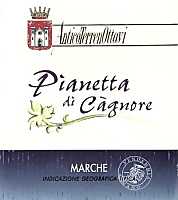
|
|
Pianetta di Cagnore 2003 |
|
| Antico Terreno Ottavi (Marches, Italy) | |
| Grapes: Vernaccia Nera | |
| Price: € 12.76 | Score: |
| This wine shows an intense ruby red color and nuances of ruby red, moderate transparency. The nose reveals intense, clean, pleasing and refined aromas that start with hints of black cherry, black currant and plum followed by aromas of carob, violet, vanilla and black pepper. The mouth has good correspondence to the nose, a slightly tannic attack and however balanced by alcohol, good body, intense flavors. The finish is persistent with flavors of black cherry, black currant and plum. Pianetta di Cagnore ages in barrique for 16-18 months. | |
| Food Match: Broiled meat, Stewed meat with mushrooms, Stuffed pasta | |
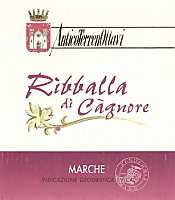
|
|
Ribballa di Cagnore 2003 |
|
| Antico Terreno Ottavi (Marches, Italy) | |
| Grapes: Montepulciano | |
| Price: € 12.76 | Score: |
| The wine shows an intense ruby red color and nuances of ruby red, moderate transparency. The nose denotes intense, clean, pleasing and refined aromas that start with hints of plum jam and black cherry jam followed by aromas of dried violet, vanilla, tobacco, carob and menthol. The mouth has good correspondence to the nose, a tannic attack and however balanced by alcohol, good body, intense flavors. The finish is persistent with flavors of plum jam and black cherry jam. Ribballa di Cagnore ages for 16-18 months in barrique. | |
| Food Match: Roasted meat, Braised and stewed meat, Broiled meat and barbecue | |
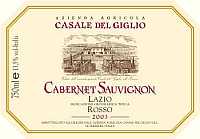
|
|
Cabernet Sauvignon 2003 |
|
| Casale del Giglio (Latium, Italy) | |
| Grapes: Cabernet Sauvignon | |
| Price: € 14.40 | Score: |
| This Cabernet Sauvignon shows an intense ruby red color and nuances of ruby red, little transparency. The nose reveals intense, clean, pleasing, refined and elegant aromas which start with hints of black cherry, plum and black currant followed by aromas of violet, blueberry, vanilla, tobacco, bell pepper, cinnamon and menthol. The mouth has good correspondence to the nose, a tannic attack and however balanced by alcohol, good body, intense flavors. The finish is persistent with flavors of black cherry, plum and black currant. A well made wine. This Cabernet Sauvignon ages for 18-20 months in barrique. | |
| Food Match: Roasted meat, Stewed and braised meat, Hard cheese | |
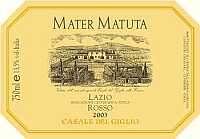
|
|
Mater Matuta 2003 |
|
| Casale del Giglio (Latium, Italy) | |
| Grapes: Syrah (85%), Petit Verdot (15%) | |
| Price: € 24.00 | Score: |
| Mater Matuta shows an intense ruby red color and nuances of ruby red, little transparency. The nose reveals intense, clean, pleasing, refined and elegant aromas which start with hints of black cherry, plum and black currant followed by aromas of vanilla, violet, blueberry, black pepper, chocolate, tobacco, licorice, mace and eucalyptus. The mouth has excellent correspondence to the nose, a tannic attack and however balanced by alcohol, full body, intense flavors, agreeable. The finish is very persistent with long flavors of black cherry, black currant and plum. A well made wine. Mater Matuta ages for 22-24 months in barrique followed by 6-8 months of aging in bottle. | |
| Food Match: Game, Roasted meat, Braised and stewed meat with mushrooms, Hard cheese | |
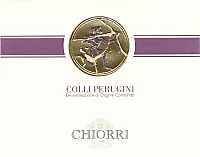
|
|
Colli Perugini Rosso 2003 |
|
| Chiorri (Umbria, Italy) | |
| Grapes: Sangiovese (50%), Merlot (30%), Cabernet Sauvignon (20%) | |
| Price: € 8.00 | Score: |
| The wine shows an intense ruby red color and nuances of ruby red, moderate transparency. The nose denotes intense, clean and pleasing aromas that start with hints of black cherry, plum and raspberry followed by aromas of blackberry, violet and cyclamen. The mouth has good correspondence to the nose, a slightly tannic attack and however balanced by alcohol, good body, intense flavors. The finish is pretty persistent with flavors of plum and black cherry. This Colli Perugini Rosso ages for 10 months in steel tanks followed by 18 months of aging in bottle. | |
| Food Match: Pasta with meat and mushrooms, Broiled meat and barbecue, Sauteed meat | |
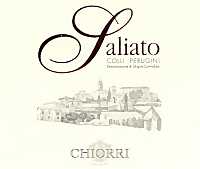
|
|
Colli Perugini Rosso Saliato 2003 |
|
| Chiorri (Umbria, Italy) | |
| Grapes: Sangiovese (50%), Merlot (30%), Cabernet Sauvignon (20%) | |
| Price: € 10.00 | Score: |
| Colli Perugini Rosso Saliato shows a brilliant ruby red color and nuances of garnet red, moderate transparency. The nose denotes intense, clean, pleasing and refined aromas which start with hints of black cherry, blackberry and plum followed by aromas of vanilla, blueberry, tobacco and carob. The mouth has good correspondence to the nose, a tannic attack and however balanced by alcohol, good body, intense flavors. The finish is persistent with flavors of plum and blackberry. This wine ages in barrique followed by 18 months of aging in bottle. | |
| Food Match: Roasted meat, Braised and stewed meat, Hard cheese | |

|
|
Prosecco di Valdobbiadene Vigneti del Fol 2005 |
|
| Bisol (Veneto, Italy) | |
| Grapes: Prosecco | |
| Price: € 18.50 | Score: |
| Prosecco di Valdobbiadene Vigneti del Fol shows a brilliant greenish yellow color and nuances of greenish yellow, very transparent, good effervescence, fine and persistent perlage. The nose denotes intense, clean, pleasing and refined aromas that start with hints of apple, pear and wistaria followed by aromas of acacia, hawthorn, broom, peach and litchi. The mouth has good correspondence to the nose, a crisp and effervescent attack, however balanced by alcohol, intense flavors, agreeable smoothness. The finish is persistent with flavors of pear, apple and litchi. | |
| Food Match: Fish and crustaceans appetizers, Risotto with crustaceans and vegetables | |

|
|
Duca di Dolle |
|
| Bisol (Veneto, Italy) | |
| Grapes: Prosecco | |
| Price: € 30.00 - 375ml | Score: |
| Duca di Dolle shows a brilliant amber yellow color and nuances of amber yellow, transparent. The nose reveals intense, clean, pleasing and refined aromas which start with hints of dried fig, dried apricot and almond followed by aromas of candied fruits, date, acacia honey, quince jam, lavender, vanilla, citrus fruits peel and nail polish. The mouth has good correspondence to the nose, a sweet and round attack, however balanced by alcohol, good body, intense flavors, agreeable. The finish is persistent with flavors of date, dried apricot and candied fruits. Duca di Dolle was bottles in 2006 and it is made by assembling 14 different vintages, from 1991 to 2005. | |
| Food Match: Confectionery, Almond tarts, Hard cheese | |
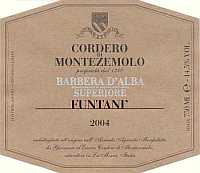
|
|
Barbera d'Alba Superiore Funtanì 2004 |
|
| Cordero di Montezemolo (Piedmont, Italy) | |
| Grapes: Barbera | |
| Price: € 20.00 | Score: |
| The wine shows an intense ruby red color and nuances of ruby red, little transparency. The nose denotes intense, clean, pleasing and refined aromas which start with hints of cherry, violet and plum followed by aromas of blueberry, vanilla, tobacco, pink pepper, licorice, chocolate and menthol. The mouth has good correspondence to the nose, a tannic attack and pleasing crispness, however balanced by alcohol, good body, intense flavors. The finish is persistent with flavors of cherry, plum and blueberry. Barbera d'Alba Superiore Funtanì ages in cask for 15 months followed by at least 6 months of aging in bottle. | |
| Food Match: Roasted meat, Stewed and braised meat with mushrooms | |
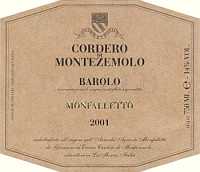
|
|
Barolo Monfalletto 2001 |
|
| Cordero di Montezemolo (Piedmont, Italy) | |
| Grapes: Nebbiolo | |
| Price: € 28.00 | Score: |
| This Barolo shows a brilliant ruby red color and nuances of brick red, moderate transparency. The nose reveals intense, clean, pleasing, refined and elegant aromas that start with hints of cherry, plum and violet followed by aromas of raspberry, strawberry, vanilla, rose, tobacco, cocoa, licorice, cinnamon, leather and menthol. The mouth has good correspondence to the nose, a tannic attack and pleasing crispness, however balanced by alcohol, full body, intense flavors. The finish is persistent with flavors of cherry, plum and raspberry. A well made wine. Barolo Monfalletto ages for 18-22 months in cask. | |
| Food Match: Game, Roasted meat, Stewed and braised meat, Hard cheese | |
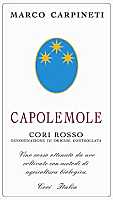
|
|
Cori Rosso Capolemole 2005 |
|
| Marco Carpineti (Latium, Italy) | |
| Grapes: Montepulciano, Nero Buono, Cesanese | |
| Price: € 9.00 | Score: |
| The wine shows an intense ruby red color and nuances of ruby red, little transparency. The nose denotes intense, clean and pleasing aromas which start with hints of black cherry and plum followed by aromas of blueberry, cyclamen, tobacco and vanilla. The mouth has good correspondence to the nose, a slightly tannic attack and however balanced by alcohol, good body, intense flavors. The finish is persistent with flavors of black cherry and plum. This wine ages for 6-8 months in cask. | |
| Food Match: Broiled meat, Stewed meat, Roasted meat | |
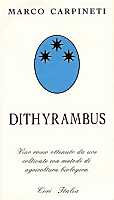
|
|
Dithyrambus 2003 |
|
| Marco Carpineti (Latium, Italy) | |
| Grapes: Montepulciano (60%), Nero Buono (40%) | |
| Price: € 16.00 | Score: |
| The wine shows a deep ruby red color and nuances of garnet red, little transparency. The nose denotes intense, clean, pleasing and refined aromas which start with hints of black cherry, plum and blackberry followed by aromas of violet, vanilla, tobacco, cyclamen, carob, mace and leather. The mouth has good correspondence to the nose, a tannic attack and however balanced by alcohol, full body, intense flavors. The finish is persistent with flavors of black cherry, plum and blackberry. Dithyrambus ages for 24 months in cask. | |
| Food Match: Roasted meat, Braised and stewed meat, Hard cheese | |
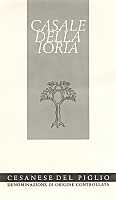
|
|
Cesanese del Piglio 2005 |
|
| Casale della Ioria (Latium, Italy) | |
| Grapes: Cesanese di Affile (55%), Cesanese (45%) | |
| Price: € 6.40 | Score: |
| This wine shows an intense ruby red color and nuances of ruby red, moderate transparency. The nose denotes intense, clean and pleasing aromas which start with hints of cherry, blueberry and plum followed by aromas of raspberry, blackberry and violet. The mouth has good correspondence to the nose, a slightly tannic attack and pleasing crispness, however balanced by alcohol, good body, intense flavors. The finish is persistent with flavors of cherry and raspberry. This wine ages for 4-5 months in cask followed by 6 months of aging in bottle. | |
| Food Match: Sauteed meat, Legumes soups, Stewed meat | |
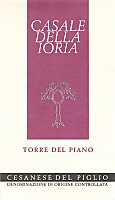
|
|
Cesanese del Piglio Torre del Piano 2004 |
|
| Casale della Ioria (Latium, Italy) | |
| Grapes: Cesanese di Affile | |
| Price: € 10.33 | Score: |
| The wine shows a brilliant ruby red color and nuances of ruby red, moderate transparency. The nose reveals intense, clean, pleasing and refined aromas that start with hints of cherry, raspberry and plum followed by aromas of cyclamen, vanilla, blueberry, pink pepper, menthol, carob and mace. The mouth has good correspondence to the nose, a slightly tannic attack and pleasing crispness, however balanced by alcohol, good body, intense flavors. The finish is persistent with flavors of cherry, raspberry and plum. Cesanese del Piglio Torre del Piano ages for 8 months in cask followed by 6 months of aging in bottle. | |
| Food Match: Sauteed meat with mushrooms, Broiled meat and barbecue, Stewed meat | |
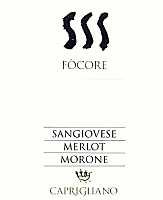
|
|
Focore 2002 |
|
| Caprigliano (Latium, Italy) | |
| Grapes: Sangiovese (50%), Merlot (40%), Morone (10%) | |
| Price: € 5.50 | Score: |
| The wine shows an intense ruby red color and nuances of ruby red, moderate transparency. The nose denotes intense, clean, pleasing and refined aromas which start with hints of black cherry, plum and blueberry followed by aromas of violet, carob, tobacco and vanilla. The mouth has good correspondence to the nose, a slightly tannic attack and pleasing roundness, however balanced by alcohol, good body, intense flavors. The finish is persistent with flavors of black cherry and plum. Focore ages for 6 months in barrique followed by 6 months of aging in bottle. | |
| Food Match: Stewed meat with mushrooms, Stuffed pasta, Roasted meat | |
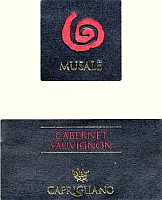
|
|
Musalè 2001 |
|
| Caprigliano (Latium, Italy) | |
| Grapes: Cabernet Sauvignon | |
| Price: € 5.50 | Score: |
| Musalè shows a brilliant ruby red color and nuances of ruby red, moderate transparency. The nose denotes intense, clean, pleasing and refined aromas that start with hints of black cherry, blueberry and black currant followed by aromas of plum, violet, raspberry, vanilla, pink pepper, cyclamen and carob. The mouth has good correspondence to the nose, a tannic attack and however balanced by alcohol, good body, intense flavors. The finish is persistent with flavors of black cherry, black currant and raspberry. Musalè ages for 12 months in steel tanks, 12 months in cask and 6 months in bottle. | |
| Food Match: Roasted meat, Stewed and braised meat, Hard cheese | |
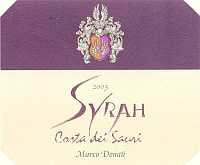
|
|
Syrah Costa dei Sauri 2003 |
|
| Marco Donati (Trentino, Italy) | |
| Grapes: Syrah | |
| Price: € 11.00 | Score: |
| Syrah Costa dei Sauri shows a brilliant ruby red color and nuances of ruby red, moderate transparency. The nose reveals intense, clean, pleasing and refined aromas which start with aromas of black cherry and plum followed by aromas of blueberry, violet, vanilla, tobacco and carob. The mouth has good correspondence to the nose, a slightly tannic attack and pleasing roundness, however balanced by alcohol, good body, intense flavors. The finish is persistent with flavors of black cherry, plum and blueberry. Syrah Costa dei Sauri ages in barrique. | |
| Food Match: Roasted meat, Stewed meat, Broiled meat and barbecue, Cheese | |
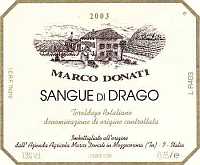
|
|
Teroldego Rotaliano Sangue di Drago 2003 |
|
| Marco Donati (Trentino, Italy) | |
| Grapes: Teroldego | |
| Price: € 20.00 | Score: |
| This wine shows a brilliant ruby red color and nuances of ruby red, moderate transparency. The nose reveals intense, clean, pleasing and refined aromas which start with hints of black cherry, plum and blueberry followed by aromas of raspberry, cyclamen, violet, vanilla, tobacco, carob and mace. The mouth has good correspondence to the nose, a tannic attack and however balanced by alcohol, good body, intense flavors, agreeable. The finish is persistent with flavors of black cherry, blueberry and plum. Teroldego Rotaliano Sangue di Drago ages for 16-18 months in barrique. | |
| Food Match: Roasted meat, Braised and stewed meat with mushrooms, Hard cheese | |
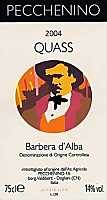
|
|
Barbera d'Alba Quass 2004 |
|
| Pecchenino (Piedmont, Italy) | |
| Grapes: Barbera | |
| Price: € 10.80 | Score: |
| Barbera d'Alba Quass shows a deep ruby red color and nuances of purple red, little transparency. The nose denotes intense, clean, pleasing, refined and elegant aromas which start with hints of cherry, plum and blueberry followed by aromas of raspberry, strawberry, violet, blackberry, cyclamen, cocoa, pink pepper and menthol. The mouth has good correspondence to the nose, a tannic attack and pleasing crispness, however balanced by alcohol, good body, intense flavors. The finish is persistent with flavors of cherry, plum and blueberry. A well made wine. Barbera d'Alba Quass ages for 12 months in cask. | |
| Food Match: Roasted meat, Braised and stewed meat with mushrooms, Hard cheese | |
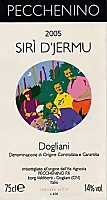
|
|
Dolcetto di Dogliani Siri d'Jermu 2005 |
|
| Pecchenino (Piedmont, Italy) | |
| Grapes: Dolcetto | |
| Price: € 9.60 | Score: |
| This wine shows an intense ruby red color and nuances of purple red, moderate transparency. The nose denotes intense, clean, pleasing, refined and elegant aromas that start with hints of cherry, blueberry and blackberry followed by aromas of raspberry, strawberry, plum, cyclamen, violet, black currant, menthol and peach. The mouth has good correspondence to the nose, a tannic attack and pleasing crispness, however balanced by alcohol, good body, intense flavors. The finish is persistent with flavors of cherry, blueberry and plum. A well made wine. Dolcetto di Dogliani Siri d'Jermu ages for 6 months in steel tanks. | |
| Food Match: Broiled meat and barbecue, Stewed meat | |
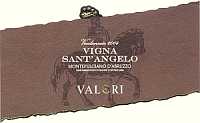
|
|
Montepulciano d'Abruzzo Vigna Sant'Angelo 2003 |
|
| Valori (Abruzzo, Italy) | |
| Grapes: montepulciano | |
| Price: € 25.20 | Score: |
| This Montepulciano d'Abruzzo shows an intense ruby red color and nuances of ruby red, little transparency. The nose reveals intense, clean, pleasing, refined and elegant aromas that start with hints of black cherry, plum and blackberry followed by aromas of blueberry, violet, vanilla, pink pepper, cinnamon, carob, mace and menthol. The mouth has good correspondence to the nose, a tannic attack and however balanced by alcohol, good body, intense flavors, agreeable roundness. The finish is persistent with flavors of black cherry, plum and blackberry. A well made wine. Montepulciano d'Abruzzo Vigna Sant'Angelo ages for 12 months in barrique followed by 12 months of aging in bottle. | |
| Food Match: Broiled meat and barbecue, Roasted meat, Braised and stewed meat | |
|
||||||||
|
DiWineTaste Polls
|
| |||||||
Privacy Policy | |||||||


| Copyright © 2002-2024 Antonello Biancalana, DiWineTaste - All rights reserved |
| All rights reserved under international copyright conventions. No part of this publication and of this WEB site may be
reproduced or utilized in any form or by any means, electronic or mechanical, without permission in writing from DiWineTaste. |